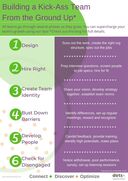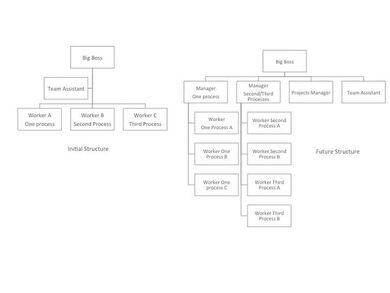Hire The Right Person FastIf you’re like many of my clients, you have probably posted a job to fill, only to find yourself sifting through 200+ UN-qualified applicants.
With the likes of Monster, Indeed and Career Builder simplifying the job hunting process has made it easy for what I call 'serial job seekers' to blast out applications to a mass number of postings without even reading the full job posting. But this doesn’t help you—you need to find the ‘right’ person to without wasting your time! This means you need to be extra diligent in your quest to hire, in order to reduce the number of serial job seekers you encounter. To help you find the right fit for your new role, follow these top 5 tips…
2 Comments
I can’t tell you how many times I’ve been asked, “should I promote from within or hire externally?” And while I wish there was a quick way to answer this question, there simply isn’t.
When this conflicting decision arises, there are several factors I look at, and recommend my clients consider, to help decide and prepare accordingly. For the most part, hiring from within is seen as a very positive practice. However, if you promote the wrong person, missing the right skills and attitude, you will have upheaval as a result. Likewise, introducing an external hire into the team can bring forth new ideas, fresh thinking and objective perspective. But if the rationale for going external is not understood by the team, and people feel overlooked the person can be rejected pretty quickly–particularly in a tight knit group with an aversion to change. Either way, hiring the wrong fit for the role or the team may lead to:
Taking time to consider the right type of people you need, who fit your environment, share the same values as the team and have the right skill set, is the key to determining whether to promote from within or hire externally. To prevent bad feelings, it is very important to consider internal staff first in your selection process before going outside of the business. To help you learn from other’s experience, I’ve highlighted some scenarios that underscore the pitfalls of in-house promotion vs. external hire. Scenario #1 – Internal Hire Meet Tony Saildude. Tony was a National Sales Director in an ever-changing, fast-paced company that was trying to acquire market share in a highly competitive industry. After his Sales Manager, Joyce Leadcraft left the company to stay at home with her 4 young children, Tony suddenly had an opening in their small business sales division. Over several years, Joyce built the team from the ground up and was always there to ensure deals made it through in a timely manner. She continuously answered policy and process questions and effectively stickhandled internal conflict with both Marketing and Operations. Acting quickly, Tony decided to select his best salesperson, Ron Sharp, for the role. Ron was well liked by the team and senior leadership, always upbeat, a great relationship builder and had been in his role for 4 years, frequently attaining the pinnacle of CEO Sales Club annually. Ron was delighted with the promotion. He received a handsome increase, a parking spot and the coveted ‘inside office’. But shortly after he was promoted, the complaints began rolling up to Tony from the team. Ron wasn’t available like Joyce had been and he didn’t take the time to solve internal issues. He usually took long lunches or breaks and frequently was seen socializing with people in Marketing. Ron was also bossy to the team, barking out deadlines and often raised his voice before closing himself in his office. And when they had internal issues with other groups, he would say things like “suck it up buttercup” leaving them frustrated and resentful. Ron’s greatest strength had always been building rapport with customers, but in his new role, he was stuck in the office all day, forced to stick-handle a myriad of questions and expected to answer to Tony–it was not a good fit for Ron. What Tony really needed was someone who could run interference internally, communicate clear direction, hold others accountable and also be readily available to resolve issues. These were skills and strengths Ron just did not have. The Learning: Questions When Promoting Internally
Scenario #2 – External Hire Meet Mary Newhere. Mary was the new Senior Vice President, Human Resources for a financial services company. The department was built on a foundation of promotions from within the company, so much so that many of the existing HR department did not have HR experience, which was why they hired Mary. Seeing that the business was about to go through quite a bit of change, Mary wanted to hire a successor who could navigate the impending transformation, so she decided to hire externally. She hired Laura Right. Laura had a 25+year HR career from different industries and was highly recommended through Mary’s network. Soon after she joined, Laura realized how tight the current team was and while they really liked her, she found that they rejected any new ideas or suggestions, even though Mary was always supportive. Two months after Laura was hired, Mary was moved to another position and Laura’s new boss became Lester Oldschool–a financial services ‘lifer’ who navigated several departments over his 30 years and was a sceptic about new ideas that may impact the culture. Laura’s peers adored Lester, complaining to him that Laura was hired too quickly and that none of them were even considered for the role. They weren’t happy that she wanted to make change to ‘tried and true’ practices. It wasn’t long before Laura became discouraged and frustrated. She had no other sponsor or support once Mary left. Although her business clients thought she was refreshing, she was unable to affect change in HR and constantly faced a battle. Laura left before her 2-year anniversary after being snapped up by another company. The Learning: Questions When Hiring Externally
Trying to decide between promoting internally versus hiring externally can be a challenge. To avoid creating an unhappy environment, remember to consider your internal staff first, measuring them appropriately against the requirements of the role, before going outside of the business. Hiring the right person and ensuring that they’re successful in their role requires careful consideration and planning. If you need assistance or guidance in this area, contact us to help you assess your environment and needs. Dots Leadership Solutions also offer pre-screening or second interview support, custom recruitment frameworks and custom tool kits to assist leaders in making the right hiring decision. Building A Kick-Ass Team is RewardingBuilding a kick-ass team is one of the most rewarding experiences for any leader. To see the team YOU established succeed and thrive creates a sense of pride and satisfaction like no other. Do you remember how it felt to be a part of an awesome team? You were in sync, you had fun, and you were an unstoppable machine. Everyone was connected and continuously driving in the same direction to get stuff done. This blog marks the beginning of a series of posts that will walk you through the full cycle of not only building a team, but also supercharging it! Today, we start from the beginning, which involves creating your vision, crafting roles and selecting the right members. Over the course of the next few months, I will address other topics such as the settling in period, navigating through difficult times, celebrating successes and preparing for transformative windups. The “Kick-Ass Team Building From the Ground Up” series will also include tons of practical tips and tricks for boosting your own leadership capabilities, so please follow along for full access to an abundance of insight and advice. Free Tip Sheet: Building a Kick-Ass Team From the Ground Up Without further ado, welcome to part one of our series – The Start Up Phase! There are countless reasons why you may be forming a new team right now. It may be the beginning of a new project or initiative, there may be an important new business direction underway and you have to pull a group together or you need to 'restructure' due to growth. Regardless of the reason behind the new team formation, here are your steps to get started: 1. White-Boarding Let me preface by stressing one thing – do not skip this step! Even if you’ve been handed a group of pre-selected individuals to begin with, I encourage all of my clients to start with a blank slate. Before you go sticking boxes on an org chart, ensure you are crystal clear on your own vision. Grab a whiteboard and begin considering these key questions:
Having this information readily available will assist you in figuring out which roles/functions are required on the team and what work you’ll be in charge of overall. It will also provide a basis to review the team’s progress once set up. 2. Suss Out The Work When beginning to build a team, it’s common for leaders to immediately think about managers – how many they need, who they will be etc. But there is a major drawback to this approach. What tends to happen is teams end up with too many people trying to lead without clear and distinct accountabilities – and you know what they say about too many cooks in the kitchen! Instead of beginning with management, I say do a bottom-up build! Start with considering the day-to-day work of your team and allow your structure to develop according to what actually needs to get done, not how many departments you want. In order to ensure you stack your structure with the right number and level of roles, consider these questions first to group like-functions:
Your answers to the questions above should start to create a picture of how many people you really need to DO the day-to-day work? And in contrast, how many managers are actually required to manage the people doing day-to-day work. If you can, quantify the output that will be delivered – you may have to make a few assumptions at this point – and think about the ROI (return on investment) of your resources. You tend to get bigger return with ‘doers’ than with ‘managers’. Here are some common pitfalls that many leaders face during this step of a new team formation:
3. Map Your Structure - Org Design This is when you get to move the boxes around. A good organizational design drives efficiency and success. When creating an organizational structure, I recommend an accountability-based approach – that establishes a hierarchy with clarity built-in so everyone will know who is on the hook for what. Clear accountability is a critical success factor for a smooth running team. Also vital, yet sadly overlooked, is ensuring that each Manager fully understands that their responsibility includes the development of all team members, not just direct reports. This includes formalized succession planning for managers to have replacement plans for their own roles – setting this up in the beginning will make your job a whole lot easier. Now layout a future focused org structure identifying how each role reports. Every role on the org chart needs a unique and clearly defined accountability in order to reduce confusion and improve self-sufficiency. Notice we haven’t talked about the people yet? This is done on purpose. Million Dollar Tip: Never design your structure around your people. Big mistake! (Send me a message if you want to know why) Here is an example of how you might divide work initially in order to support your longer-term structure to ramp up staffing over time: Org Design ExampleOrg structures do naturally evolve as changes are introduced over time. By developing a future plan from the outset with a ‘target’ operating model (future structure) you have a tool to not only aid in the hiring/selection process, but assess potential talent to grow and develop into expanded roles. 4. Spec Your Jobs I know this may seem tedious, but believe me, this is worth the investment! Not only will this step get you thinking about what work is needed to be done and the talent you will need, but also the document you create will serve multiple purposes over the life cycle of the team (e.g. sourcing new hires, evaluating compensation, performance management). Each role needs its own job spec - a profile. Here is a free template you can use, with a filled in example of a completed one for you to reference. Consider all the elements - similar to a job posting you would need - which details the skills necessary, the type of characteristics required to be successful and the education or knowledge which is a must or nice to have in each job. If you’ve never done this before, you can cheat by ‘Googling’ similar jobs and reviewing postings for relevant content. They will give you a clue for the type of jobs in the market (no one I know ever got into trouble for using another job posting for inspiration). Just ensure your job spec thoroughly outlines the work duties, tasks, and responsibilities so that a potential employee has an idea of what they’ll be signing up for! 5. Pick Your Talent Finally, it’s time to talk about people. I could write a whole blog on just this step – I love selecting talent – but I’ll save that for another time! I’ll keep this section brief. If you already have a pool of people to select from, resist the temptation to simply slot in people you know in the boxes. Do yourself a favour and review them against the job spec for ‘fit’, and ask yourself if they are the right people to do the job. If not, you may need to post the role. This is the step where it really pays to have objective help in screening candidates and conducting interviews. Having someone to whittle the list of candidates down to a choice few will save you time – they can also be your point person to field follow up calls and emails. I highly recommend involving several people you trust in the interview stage to help you screen for ‘fit’. It’s important that anyone new joining the team or business matches both the style and organizational culture of the company. If you have management roles, start filling those first and perhaps have them join you in future interviews as you build out the team. Prepare a series of questions that will help you probe and qualify the candidates until you find the right people to fill your roles. I recommend considering the use of a comprehensive assessment tool that can give yet another dimension about fit to the team and clues for how best to manage and communicate moving forward. Dots Leadership Solutions can assist you with crafting your structure, developing job specs, preparing your selection strategy and even screening, assessing and interviewing candidates – it’s kind of our ‘thing’. Reach out today and let’s chat about the next team you’re building. Summary: Team Start Up PhaseConclusion of the Start Up Phase:
'Building a Kick-Ass Team from the ground up' series Part 2 – Team Identity |
Most Popular Posts:
AuthorElaine Adamson is a leadership consultant with Dots Leadership Solutions Inc. A natural dot connector. Passionate about coaching team effectiveness and leadership development she shares over 25+ years of real-life tips and tricks that really work! 
Elaine believes you can discover and leverage strengths to forge a strong team dynamic despite business challenges or organizational change.
She posts some great articles on Linked In too! Topics of Interest
All
Archives By Date
November 2022
|
Specialties |
Company |
|






 RSS Feed
RSS Feed